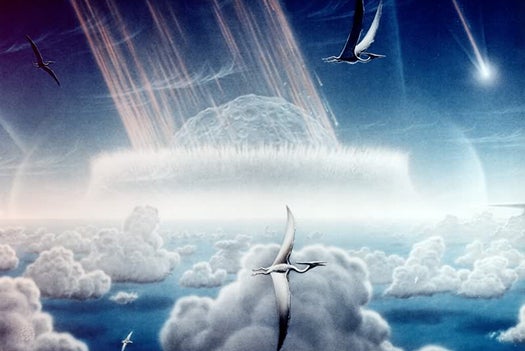Did A Comet Kill The Dinosaurs?
New data seems to suggest that one did.

Some 66 million years ago, a giant space object of some kind slammed into Earth right around the Yucatan peninsula. The resultant explosion sent debris high into the atmosphere; the dust resettled to earth newly enriched with the elements iridium and osmium–elements that are much more abundant in space than on Earth–and formed a thin layer in the rock strata now called the K-Pg boundary. A side effect of this violent impact was the extinction of most of the megafauna–dinosaurs, etc–living during that time. The impact site itself was discovered in 1978 by a geologist working for an oil company, but it wasn’t until 1990 that the now-named Chicxulub crater was associated with the proposed impact that caused the mass extinctions. Since 1990, scientists have debated the nature of the rock that hit Earth–asteroid or comet? The scientists know generally how big the explosion would have had to be in order to create the fallout found in drill samples. Based on the size of the explosion and the amount of iridium and osmium deposited at the K-Pg boundary, the most common theory is that the impactor was carbonaceous asteroid about 13 kilometers across. But scientists from Darmouth College argue that the real culprit was a comet.
Presenting their findings at the 44th Lunar and Planetary Science Conference in Texas this week, Jason Moore explained two separate findings that lead to the team’s conclusions. First, Moore and colleagues re-evaluated the iridium and osmium deposits at the K-Pa boundary. New data on those deposits indicate that the overall amount of space-derived iridium in the layer is lower than previously measured. As such, Moore and his colleagues concluded that the bolide — the impactor — was not 13 kilometers wide, because an asteroid that size would have left more iridium in the K-Pa boundary than what has been found. This by itself presents a problem, though: most asteroids are traveling too slowly for a smaller rock to generate the 3×10^23 J-giant boom that created Chicxulub crater. Comets, on the other hand, travel a lot faster than asteroids. A comet of 7 kilometers across traveling at typical comet velocities could release enough energy upon impact to create the crater and extinction event.
When Moore and colleagues looked at the catalogues of the currently known populations of asteroids and comets in the solar system, they found that some 99.99% of all impactor candidates with masses and velocities in the right ranges are comets. Obviously, this is only one study (or, well, two studies that lead to one conclusion), and Moore et al. are not the first scientists to suggest that T. rex was pwnd by a comet. But it’s a pretty cool study and it certainly provides more fuel for those who are freaked out about the future of civilization: There are only about 2 million asteroids over one kilometer wide in the solar system; scientists estimate that there are up to a trillion comets out there. Given that the average comet is about the same size as the one that Moore et al. suggested hit Earth 66 million years ago, then maybe the worrywarts are on to something…